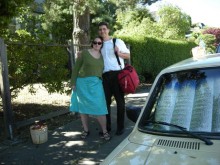
29
Aug
The week I arrived at college I purchased my trusty steed, a classic Raleigh three-speed bicycle. Augmenting the bright reflectors fore, aft, and sideways, a generator applied to the rear wheel powered the bold headlamp. A sturdy rear rack supported the book- or grocery-filled saddlebags. A tuneful bell announced my progress. Versatile, practical, and a good fit, the bicycle served me well.
Seelye’s parents gave us a rounded black dowager Peugeot 403 sedan for a wedding present. I was hit from behind in the Arboretum, a blow that creased the roof, flattened the front right tire on the stone curb, and crumpled the trunk. Though the steak and clean laundry within survived intact, I replaced the totaled car with a larger white Peugeot 504 sedan. I thought of the car as Snowy, after Tintin”s dog, Milou, translated into English. While sporty to drive, the model year 1973 proved to be an idiosyncratic mixture of parts and the car difficult to maintain. For example, when they failed the armature, motor, and electrical parts for the vital windshield wipers came from three different manufacturers in France and Germany. Luckily I found a great mechanic and learned to listen to him with the attention I soon paid to our pediatrician.
With the advent of children I remembered my ancestor of Coryell’s Ferry, New Jersey, across the Delaware River from New Hope, Pennsylvania. He ferried folk, goods, and General George Washington, who gave him his fishhook collection in gratitude. It is no longer on the map or GPS because after the Civil War, a senator Lambert changed the name to his, Lambertville. By 1986, however, the Peugeot (Puget) ceased to be reliable for carpooling elementary and preschool classmates of Carl and Maria. While it sat at the shop during Thanksgiving awaiting a new radiator, after Carl and Maria snacked on popping candies that drifted below the seats on a summer road trip to eastern Washington and Mt. Rainier, a rat ate a hole in the upholstery. Even mended, ever after Maria refused to sit on that side of the backseat, even in the next car!
Methodically, even overbearingly, I set about researching a replacement with a view to mechanics, economics, and feel. During the same week I test drove the Volvo 245 station wagon with the option of a third seat for two children up to 100 pounds, a woman driver of the 244 sedan turned a corner in downtown Seattle, beside a flat-bed truck carrying cement panels for a skyscraper facade. As they turned in tandem, some panels slid off the top of the load onto the roof of her Volvo, flattening the top of the car. The roof lowered slowly enough and only far enough to permit the driver to crouch in the leg well and stretch over the gearshift onto both seats. While it took a couple of hours to extricate her, she emerged uninjured. Of the strength of the steel-protected passenger cabin this was powerful evidence, enough to overcome the contrived advertisement Volvo later withdrew that depicted a Volvo sedan holding up a small truck on its roof.
So with Seelye’s help, I traded in the Peugeot and purchased the Volvo 245 outright at the equivalent cost then of one full year of college, room, board, and tuition. Not luxurious, but practical: with automatic transmission, wheel hubs for snow tires, a locking gas cap, and third seat folded under the cargo bed in the rear. My father used to say to me, “Have a little faith, Julie.” I chose his and my favorite yellow flax color and thereafter drove the slightly underpowered “stately tank” with pleasure and confidence. No buyer’s remorse at the expenditure, which exceeded the down payment on our house. The next largest check we wrote when Carl himself went to college. A work horse, a Percheron, of a car.
Now my Volvo is the age of majority. I am reminded of my high school foursome date with Rick Saulnier to hear Joan Baez sing in Kenmore Square, Boston. He drove into our driveway in Lexington, courteously greeted my parents, and seated me in the middle of the front seat for the drive to Brookline for the other girl. As I complimented him on his cared-for chariot, he said, “I call her Shasta.”
“For the mountain or the daisy?”
“Neither, she’asta have new shocks, new tires… always something.”
The car, like faith, needs renewal. What is the responsible ecological and economical course? How to evaluate the true costs? At the time of purchase, Beth in the dealer’s service department (a pioneer to have a woman in that responsible position then) educated me that to buy the car in replacement parts would cost 10% more than the purchase price. With time, parts would be harder to find. And who could predict the currency exchange values for a foreign product? Should I fix it, sell it, donate it? Prudent use of a car is still necessary in hilly Seattle.
Buddhists vow: “I believe in Buddha, I believe in Sangha, the community, and I believe in Dharma, truth. Dharma gates are numberless, I vow to enter them all.” Thus what to do with my car is a gateway to new thinking in the era of climate change, and a metaphor for my own aging. “She’asta.” Mountain, flower, deed.


Julie Coryell”s Ferry. L. by Maria C-M, 8/08. R. 20 July 2008. Just married in the Seattle homestead garden! Sarah Irene Starkweather and Carl William Coryell-Martin on way to Kenmore Air seaplane (watermer) ride to their honeymoon in Victoria, B.C.